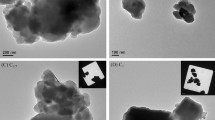Abstract
IN connexion with the work of the Pneumoconiosis Research Unit into the cause of pneumoconiosis, attention has been devoted to the problem of identifying and estimating the quantity of respirable constituents of the dusts found dispersed in the air in collieries. It was considered that a technique based on the plastic behaviour of fine particles as observed by me1 and later confirmed by Bangham and Berkowitz2 might be evolved.
This is a preview of subscription content, access via your institution
Access options
Subscribe to this journal
Receive 51 print issues and online access
$199.00 per year
only $3.90 per issue
Buy this article
- Purchase on Springer Link
- Instant access to full article PDF
Prices may be subject to local taxes which are calculated during checkout
Similar content being viewed by others
References
Boddy, R. G. H. B., Nature, 151, 54 (1943); Fuel, 22, 56 (1943); “Ultra-fine Structure of Coals and Coke” (Brit. Coal Util. Res. Assoc., 1943).
Bangham and Berkowitz, Research, 86 (1947).
Author information
Authors and Affiliations
Rights and permissions
About this article
Cite this article
BODDY, R. Microscopical Identification of the Constituents of Coal Dust. Nature 171, 928–929 (1953). https://doi.org/10.1038/171928a0
Issue Date:
DOI: https://doi.org/10.1038/171928a0
Comments
By submitting a comment you agree to abide by our Terms and Community Guidelines. If you find something abusive or that does not comply with our terms or guidelines please flag it as inappropriate.



